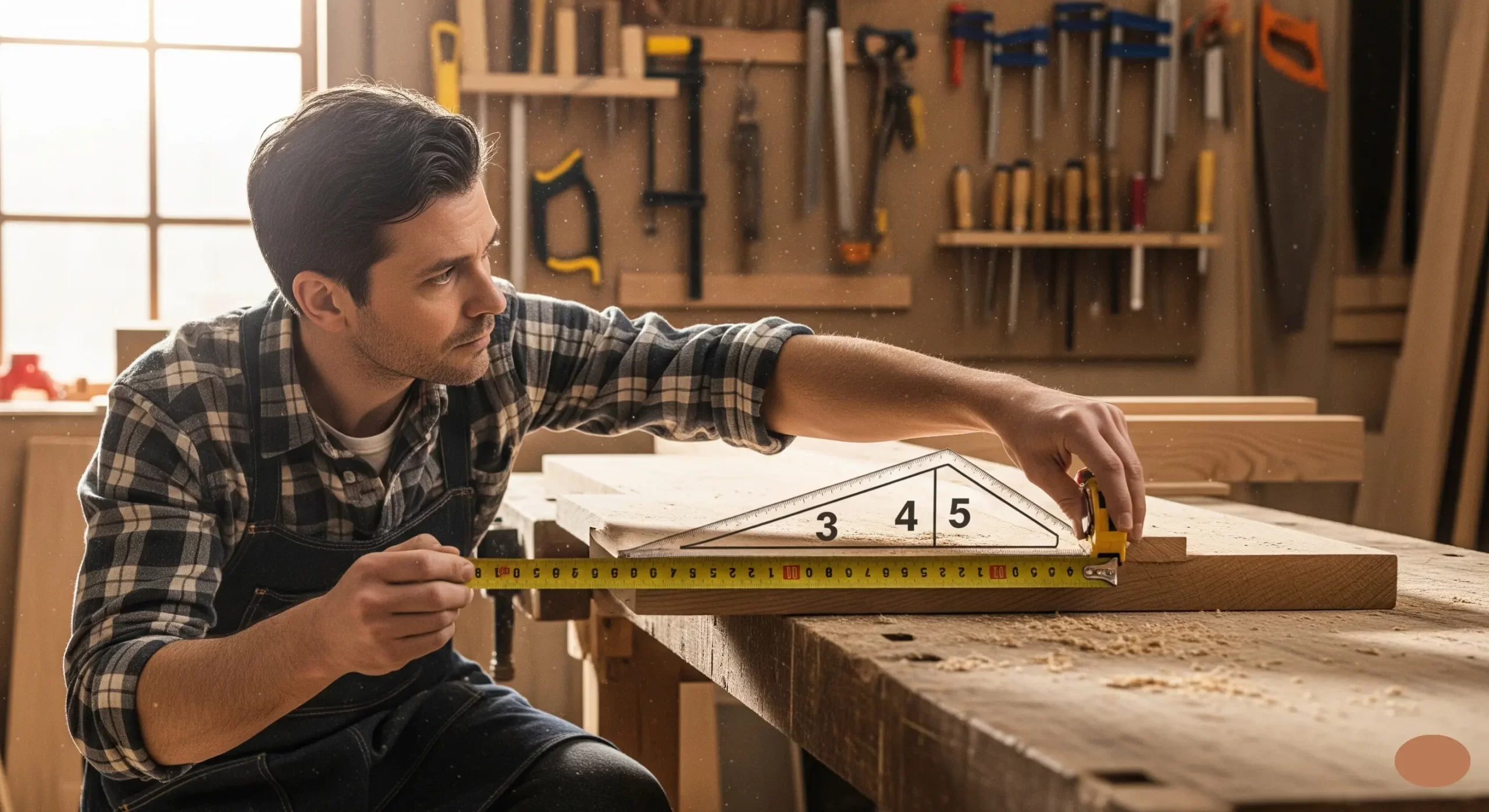
- Start at a corner where two lines will meet. This will be your reference point.
- From that point, measure out 3 feet (or any consistent unit) along one line.
- From the same corner, measure 4 feet along the perpendicular line.
- Now, measure the distance between the end of the 3-foot mark and the end of the 4-foot mark. It should measure 5 feet or any equivalent using the same scale.
If the distance is not accurate, you will need to adjust your lines until they conform to the rule. This small adjustment can make a vast difference in the quality of your finished project.
Understanding the importance of the 345 Rule in Carpentry goes beyond just getting straight lines. Here are some key reasons why it is fundamental in carpentry:
- Accuracy: Ensuring that angles are correct leads to a well-built structure. Misalignment can create problems in later stages of construction.
- Efficiency: By using the 345 Rule in Carpentry, you can identify and fix issues early in the process, saving you time and effort.
- Structural Integrity: Proper angles contribute to the durability of the structure. A solid frame is essential for long-lasting results.
In many carpentry tasks, confusion often arises between measuring and layout. What Is The 345 Rule in Carpentry? eliminates this ambiguity because it provides a clear method for verifying that angles are square. Whether you’re building a deck, framing walls, or constructing furniture, knowing how to apply the 345 Rule in Carpentry ensures you create a foundation that is not only beautiful but functional as well.
If you’re looking to further explore carpentry techniques, resources such as Wood Magazine and Popular Woodworking offer valuable insights into advanced methods and foundational tips.
Feet to Inches Conversion
| Measurement | Feet | Inches |
|---|---|---|
| 3 | 3 ft | 36 in |
| 4 | 4 ft | 48 in |
| 5 | 5 ft | 60 in |
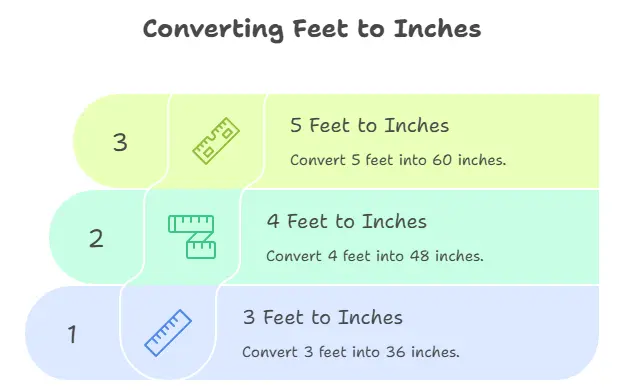
Another interesting aspect of the 345 Rule in Carpentry is that it can easily be scaled for larger projects. If you are dealing with larger dimensions, you can maintain the same ratios. For example, you could measure out 30 feet, 40 feet, and check for a distance of 50 feet. This capability makes the 345 Rule in Carpentry a reliable tool at any scale, whether you’re working on small crafts or grand constructions.
Mastering the 345 Rule in Carpentry is essential for anyone serious about carpentry. Its application can elevate your work from amateur to professional. By ensuring your angles are accurate, you lay the groundwork for a project that not only looks impeccable but stands the test of time.
For more hands-on tips and tricks, consider joining forums or communities online where carpentry enthusiasts share their experiences and advice. Websites like Instructables have great resources for learning practical applications of What Is The 345 Rule in Carpentry?.
Practical Applications of the 345 Rule in Home Improvement Projects
Understanding the 345 Rule in Carpentry can significantly elevate your home improvement projects. This simple yet effective guideline helps ensure that your walls, flooring, and other structures are square, allowing for precise measurements and fitting. With this method, you can prevent costly mistakes that could derail your entire project.
The 345 Rule in Carpentry is based on the Pythagorean theorem. It states that if you create a right triangle where one side measures 3 units, the second side measures 4 units, then the hypotenuse (the longest side) will measure 5 units. In practice, this means that if your measurements are accurate, you can check whether your corners are square. For most home improvement endeavors, having square corners is essential. Poor corners can lead to crooked walls or misaligned cabinets, resulting in a less professional finish.
Using the 345 Rule in Various Home Improvement Projects
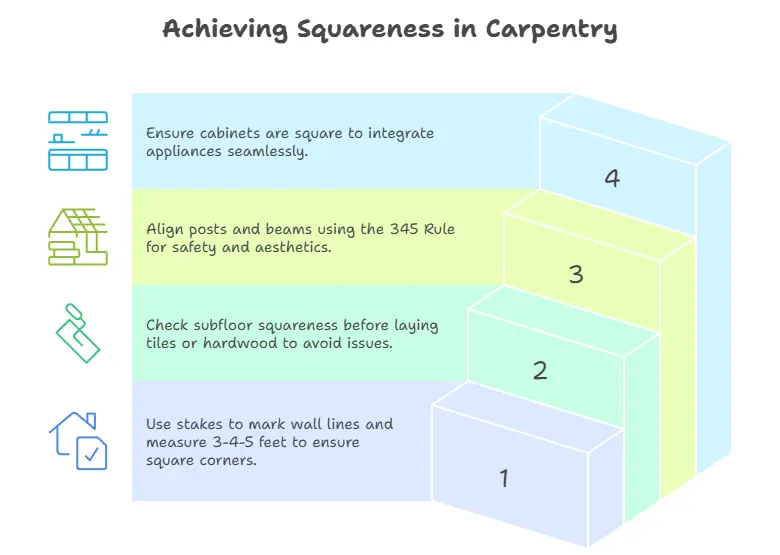
When undertaking different types of renovation work, applying the 345 Rule in Carpentry can make a world of difference:
- Framing Walls: When framing, first mark out the existing wall line with stakes. To ensure accuracy, measure 3 feet from one corner and 4 feet from the other. If you measure 5 feet between these two points, you’ve established a square corner.
- Installing Floors: Use the 345 Rule in Carpentry to check that your subfloor is perfectly square before laying down tiles or hardwood flooring. Ensure you start your initial rows square; this will save you a lot of hassle as you progress.
- Building Decks: When constructing decks, the 345 Rule in Carpentry is vital to guarantee the proper alignment of posts and beams. This will ensure both safety and aesthetic appeal.
- Cabinet Installation: When installing kitchen cabinets, using the 345 Rule in Carpentry will help to avoid gaps or uneven spaces. A square layout allows for seamless integration of appliances and countertop installations.
Step-by-Step Application of the 345 Rule
Here’s how you can put the What Is The 345 Rule in Carpentry? into action:
- Gather Your Materials: You will need a tape measure, chalk line, stakes, and a pencil.
- Set Your Corner Points: Mark the desired corner of your project using stakes or chalk.
- Measure 3 and 4 Feet: From your initial corner point, measure 3 feet along one side and 4 feet along the adjacent side. Mark these points.
- Measure the Hypotenuse: measure the distance between these two marks. If it measures exactly 5 feet, you have a perfect square.
- Adjust as Necessary: If the measurement isn’t accurate, adjust your corner until it fits the 345 Rule in Carpentry
Benefits of the 345 Rule
There are several benefits to applying the 345 Rule in Carpentry in your home improvement tasks:
- Increased Accuracy: The rule increases the chances of straight lines and square corners, leading to an overall more polished finish.
- Cost-Effective: By reducing errors and misalignments, you can save money in materials and labor on future adjustments.
- Versatility: The 345 Rule in Carpentry can be applied in a variety of construction and renovation tasks, making it a go-to technique for DIY enthusiasts, carpenters, and contractors alike.
The 345 Rule in Carpentry into your home improvement projects is not only practical but also essential for achieving professional results. It’s a simple yet powerful technique that ensures accuracy in your measurements, promoting efficiency in your renovations. Whether you are framing walls or installing cabinets, the 345 Rule in Carpentry will help you achieve perfect results every time.
For more in-depth information on carpentry techniques and home improvement methods, check out Home Advisor or Home Repair Tutor. These resources offer valuable tips and expert advice to enhance your skills in home renovations.
Common Mistakes to Avoid When Using the 345 Rule
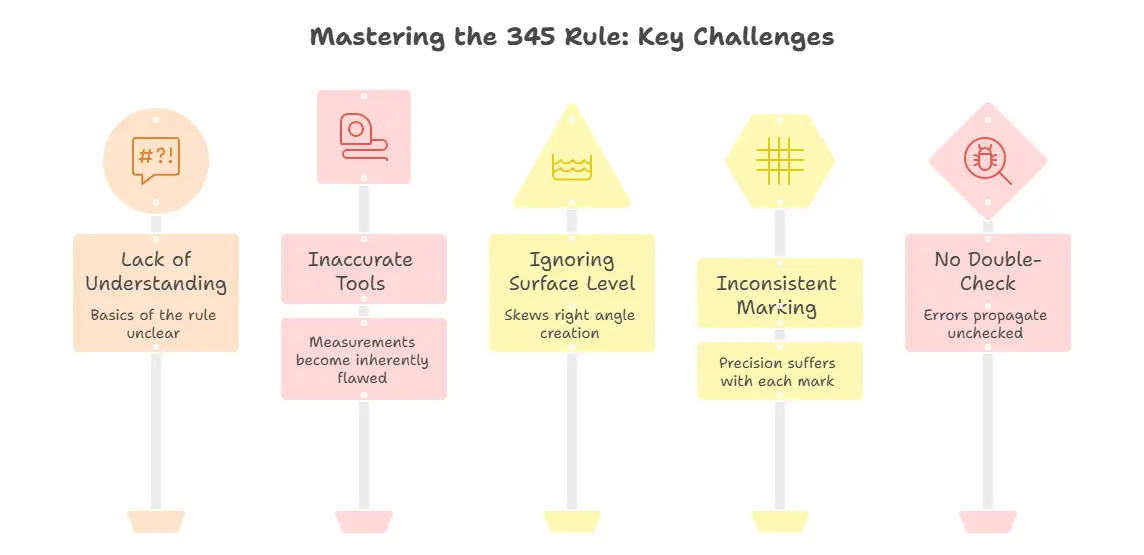
The 345 Rule in Carpentry is a popular method used by carpenters to ensure precision and accuracy when framing structures. Known for its simplicity and effectiveness, it entails creating a right triangle with the lengths of 3 feet, 4 feet, and 5 feet. While the 345 Rule in Carpentry is straightforward, there are common mistakes that can trip up even seasoned craftsmen. By being aware of these pitfalls, you can enhance your accuracy and craftsmanship.
Not Understanding the 345 Rule Basics
Before diving into projects, it’s crucial to fully understand how the 345 Rule in Carpentry works. The foundational concept involves the Pythagorean theorem, where the square of the hypotenuse is equal to the sum of the squares of the other two sides. This means that when you measure out 3 feet and 4 feet from a starting point, the diagonal line should measure exactly 5 feet to create a right angle. Skipping this understanding can lead to errors right from the beginning.
Using Inaccurate Measuring Tools
Another common mistake occurs when carpenters use inaccurate measuring tools. It’s essential to use reliable tools, such as a tape measure that is not frayed or damaged. If your measurements are off by just a fraction, it can lead to significant discrepancies in your work.
Ignoring Surface Level
A flat, level surface is critical when applying the 345 rule. If you’re working on an uneven ground, your measurements can yield incorrect results. To avoid this mistake, always make sure that your area is leveled before you start measuring and marking.
Overlooking Consistent Marking Technique
Inconsistent marking can lead to confusion and mistakes. Always make sure to mark your points clearly and consistently every time you apply the rule. This can include using chalk lines or pencil marks that are distinct and easy to follow. If your markings are vague, it may result in error-prone calculations.
Failing to Double-Check Measurements
Rushing through measurements can be tempting, especially on time-sensitive projects, but it is a recipe for mistakes. Make it a habit to double-check every measurement to ensure that they align with the 345 rule. This simple step can save you from costly errors. A common approach is to measure twice and cut once, ensuring accuracy every step of the way.
Neglecting to Account for Material Thickness
When using the 345 Rule in Carpentry, it’s crucial to consider the thickness of your materials. For example, if you’re working with lumber, remember that the actual dimensions may differ from the nominal sizes. This oversight can lead to misalignment when framing or constructing in accordance with the 345 rule. Always factor in these details to keep your project on point.
Incorrectly Positioning the Triangle
The orientation of the triangle is vital. Some carpenters make the mistake of positioning the triangle incorrectly, which leads to a wrong angle. Always verify that you are measuring from the same common point for all sides of the triangle.
Not Practicing the Technique
Practice makes perfect. Many carpenters may understand the 345 Rule in Carpentry theoretically but struggle to implement it skillfully. Engaging in practice sessions can build your confidence and accuracy with the technique, so don’t be afraid to test your skills on smaller projects before jumping into large-scale designs.
Understanding and avoiding these common mistakes when applying the 345 Rule in Carpentry in carpentry can significantly improve both the quality and efficiency of your work. A great resource for further tips on carpentry can be found at Woodworker’s Source. This site provides valuable insights that can enhance your skill set and project outcomes.
By being vigilant about avoiding these common missteps, you can confidently apply the 345 rule, resulting in accurate and beautiful builds. Relying on your knowledge and skills will set you up for success in future carpentry projects.
How to Measure and Mark Right Angles with the 345 Rule
- Start by marking your first point. This will serve as one corner of your right angle.
- From this point, measure out 3 units along one edge of your intended right angle and mark this point.
- Then, from the same starting point, measure out 4 units along the other edge and make another mark.
- Now, take a tape measure or a measuring tool and measure the distance between the two marks you’ve made. If they are exactly 5 units apart, congratulations! You have successfully created a right angle.
If your measurements form a 5-unit diagonal, you can confidently proceed to make your cuts or layout your materials. If not, adjust one of your marks until you achieve the 5-unit measurement.
This method works well for a variety of carpentry projects, such as laying out foundations, building frames, or even for simple woodworking tasks. By ensuring your angles are correct, you help to maintain the structural integrity of your finished product.
It’s also important to remember that the materials you’re working with can affect the precision of your measurements. Always ensure your measuring tape is straight and free from kinks or obstructions. Additionally, use a reliable square or straightedge to give yourself a guide as you measure. This will help eliminate any discrepancies in your measurements and improve your overall accuracy.
If you’re still learning the craft, practicing the 345 Rule in Carpentry can be incredibly beneficial. Take some scrap wood and mark out different right angles using the method described. Repetition will help you become more familiar with the process, allowing you to visualize the right angles before you even begin your projects.
To further enhance your understanding of right angles, consider utilizing resources that cover basic carpentry skills. Websites such as Family Handyman provide comprehensive guides and tips for beginners. These resources are invaluable for honing your skills and ensuring you’re equipped with the knowledge necessary for successful carpentry work.
In addition, if you’re looking to purchase tools or materials, websites like Home Depot often have the tools you’ll need and can provide additional information on how to use them properly.
Creating perfect right angles is crucial for any carpentry project. The 345 Rule in Carpentry simplifies this process, making it easy for both novices and experienced carpenters to ensure accuracy in their work. Whether you’re constructing a new deck, framing a wall, or any other project that requires right angles, it should be your go-to technique for measuring and marking precise corners.
Measure carefully, use the right tools, and practice regularly. Soon, the 345 Rule in Carpentry will become second nature, allowing you to focus on honing other aspects of your carpentry skills while achieving professional-level results.
Tools and Techniques to Enhance Your Carpentry Skills with the 345 Rule
Understanding the 345 Rule in Carpentry is essential for both beginners and seasoned woodworkers. This simple yet effective technique helps ensure your angles are square, which is a fundamental aspect of quality craftsmanship. Whether you’re building furniture, framing a house, or working on small woodworking projects, this rule can significantly enhance your skills and results.
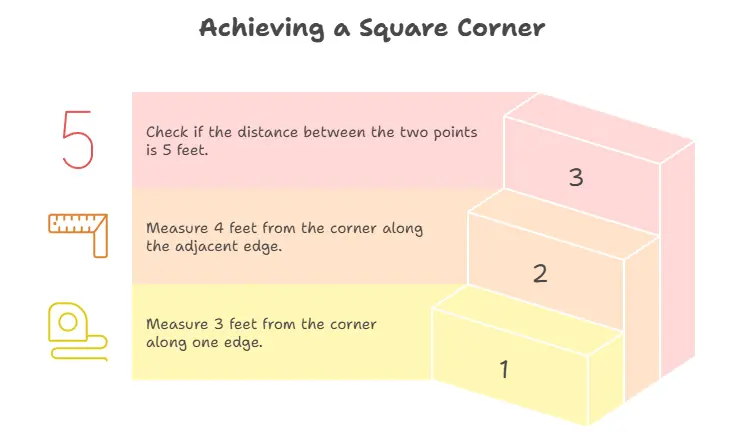
The 345 Rule in Carpentry states that if you form a right triangle where the lengths of the sides are 3 feet, 4 feet, and 5 feet, the triangle will have a perfect right angle. In an actual carpentry or woodworking situation, this rule is incredibly practical for checking your corners. Here’s how it works in detail:
- Step 1: Measure out 3 feet from the corner along one edge.
- Step 2: Measure out 4 feet from the corner along the adjacent edge.
- Step 3: The distance between the two points you’ve marked should be exactly 5 feet. If it is, your corner is square!
This technique is applicable in various situations. For example:
- When building frames for doors and windows.
- While installing cabinets in kitchens or bathrooms.
- During the layout of walls in new constructions.
Using the right tools increases your efficiency and accuracy when applying the 345 rule. Here’s a list of essential tools that can help you carry out this technique effectively:
- Tape Measure: A reliable tape measure is crucial for accurate measurements.
- Speed Square: Use this tool to mark 90-degree angles easily.
- Chalk Line: It helps you create straight lines across your workpiece.
- Level: Ensures your surfaces are flat and even.
- Square: This is essential for checking angles during the building process.
To further enhance your carpentry skills using the 345 Rule in Carpentry, consider incorporating some advanced techniques. Here are a few methods that can elevate your craftsmanship:
- Laser Level: A laser level can project straight lines over a long distance, allowing for more precision when setting up large projects.
- Two-Person Method: When working on larger structures, consider using two people to extend the 3-4-5 method. One person can hold one point while the other measures the distance, ensuring accuracy.
- Practice on Smaller Projects: Before tackling a big job, experiment with the 345 Rule in Carpentry on smaller, simpler projects to build your confidence.
One of the significant benefits of the 345 rule is that it can help you save time and materials by preventing mistakes. When you ensure your angles are square, you minimize the risk of having to redo work, which often leads to wasted materials and increased costs.
Additionally, understanding this rule leads to better joint connections. Whether you’re working with hardwoods, softwoods, or plywood, square angles will promote better stability in your projects.
Importance of the 3-4-5 Rule in Woodworking Projects
| Type of Project | Importance of the 3-4-5 Rule |
|---|---|
| Framing | Ensures that walls are correctly aligned for structural integrity. |
| Furniture Making | Leads to joints that fit snugly together, improving durability. |
| Flooring Installation | Helps avoid gaps and misalignment, contributing to a polished appearance. |
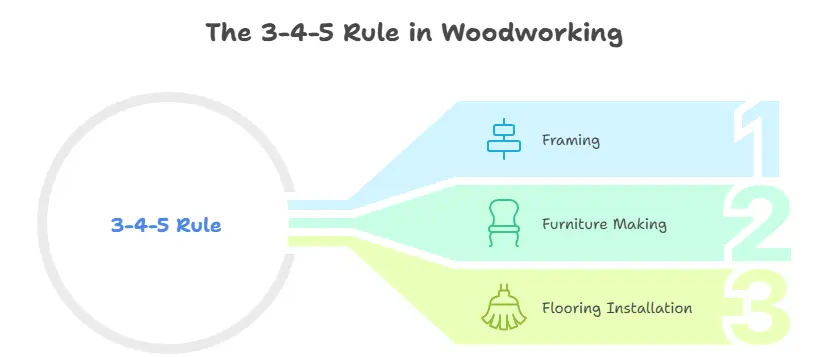
For additional resources and tools that can help you apply the 345 Rule in Carpentry, visit Wood Magazine and Fine Woodworking.
These websites offer a wealth of information on woodworking techniques, including detailed guides and expert advice.
Mastering the 345 Rule in Carpentry not only enhances your technical skills but also boosts your confidence in carpentry. As you improve your accuracy with angles and measurements, you’ll notice a significant change in the quality of your work, making every project a testament to your growing expertise.
Conclusion
Mastering the 345 Rule in Carpentry can be a game-changer for both novice and experienced DIY enthusiasts. Understanding its importance allows you to create accurate right angles, which are crucial in ensuring the integrity and aesthetics of any project. Whether you are building a deck, framing a wall, or installing cabinets, applying the 345 Rule in Carpentry can save you time and resources.
When you incorporate the 345 Rule in Carpentry into your home improvement tasks, you equip yourself with a reliable method for achieving straight and square structures. However, it’s essential to be mindful of common pitfalls, such as miscalculating the lengths of your measurements or failing to double-check your angles. Taking the time to measure twice can help avoid these costly errors.
To effectively use the 345 Rule in Carpentry, knowing how to measure and mark right angles is vital. Utilizing tools like measuring tapes, chalk lines, and squares can enhance your accuracy and efficiency. Additionally, familiarizing yourself with techniques that ensure precise alignment will elevate your carpentry skills to new heights.
Embracing the 345 Rule in Carpentry not only simplifies your carpentry tasks but also instills confidence in your abilities. As you continue practicing, you’ll find that creating perfectly squared projects becomes second nature. So, gear up, keep this rule in your toolkit, and watch your home improvement projects transform into professional-quality work. Whether you’re tackling small repairs or large renovations, the 345 Rule in Carpentry is your ticket to success in the world of carpentry.